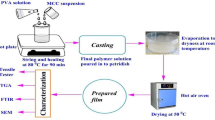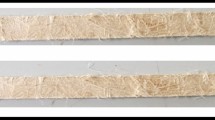Abstract
This present study investigates the role of adding sugarcane bagasse biosilica (SBB) fine particle on Opuntia dillenii fibre (ODF)-reinforced epoxy resin composite and its mechanical, thermal and laminar shear strength properties. In this study, the biosilica particles were prepared from Indiana sugarcane bagasse via thermo-chemical process. The fibre and particles were silane surface-treated (SST) using 3-aminopropyltrimethoxysilane via acid hydrolysis process. Hand layup was used to create the composites, which were then post-cured at 120 °C for 48 h. The composites were characterized using ASTM standards in order to evaluate the mechanical, thermal and laminar shear strength properties. The tensile strength of SST fibre and particle produced the highest strength of 178 MPa for 40 vol.% of fibre and 2 vol.% of particle in epoxy resin. Similarly, the SST fibre and particle retained high thermal stability than as-received fibre and particle in the composite. The laminar shear strength of SST fibre shows the highest value of 33 MPa against shear load. The SEM morphology shows highly adherence surface between SST fibre and resin. Thus, in the process of making biocomposites using plant-based fibres, the silane treatment is mandated in order to achieve high performance.







Similar content being viewed by others
Data availability
There is no data available as public. Upon request, the data can be shared.
References
Prakash VR Arun, Viswanthan R (2019) Fabrication and characterization of echinoidea spike particles and kenaf natural fibre-reinforced Azadirachta indica blended epoxy multi-hybrid bio composite. Compos A Appl Sci Manuf 118:317–326
Kavitha V, Aparna G (2021) A review on banana fibre and its properties. Asian J Pharm Res Dev 9(3):118–121
Li M, Pu Y, Thomas VM, Yoo CG, Ozcan S, Deng Y, Nelson K, Ragauskas AJ (2020) Recent advancements of plant-based natural fibre–reinforced composites and their applications. Composites Part B: Engineering 108254
Ramnath BV, Manickavasagam VM, Rajesh S, Khan A, Asiri AM, Dzudzevic-Cancar H 2021 Behavior of some natural fibre composites.” In Hybrid Natural Fibre Composites, pp. 167–183. Woodhead Publishing
Salwa HN, Sapuan SM, Mastura MT, Zuhri MYM (2019) Green bio composites for food packaging. Int J Recent Technol Eng 8:450–459
Ben Samuel J, JulyesJaisingh S, Sivakumar K, Mayakannan AV, Arunprakash VR (2021) Visco-elastic, thermal, antimicrobial and dielectric behaviour of areca fibre-reinforced nano-silica and neem oil-toughened epoxy resin bio composite. Silicon 13(6):1703–1712
Soosai, Milan, Christopher Thankian, Winowlin Jappes Jebas Thangiah, Rajini Nagarajan, Mayandi Kalimuthu, Sikiru Oluwarotimi Ismail, and Faruq Mohammad (2020) Characterization of novel lignocellulosic Spinifex littoreus fibres and their composites. J Bionic Eng
Indran S, Raj RDE, Daniel BSS, Binoj JS (2018) Comprehensive characterization of natural Cissus quadrangularis stem fibre composites as an alternate for conventional FRP composites. J Bionic Eng 15(5): 914–923
Mayandi K, Rajini N, Pitchipoo P, WinowlinJappes JT, VaradaRajulu A (2018) Properties of untreated and chemically treated Cissus quadrangularis natural fibres and their composites with polyester as the matrix. Polymer Composites 39(3):876–886
Jagatheesan K, Babu K (2020) Taguchi optimization of minimum quantity lubrication turning of AISI-4320 steel using biochar nanofluid. Biomass Conversion and Biorefinery 1–8
Karthigairajan M, Nagarajan PK, Raviraja Malarvannan R, Ramesh Bapu BR, Jayabalakrishnan D, Maridurai T, Shanmuganathan VK (2020) Effect of silane-treated rice husk derived biosilica on visco-elastic, thermal conductivity and hydrophobicity behavior of epoxy biocomposite coating for air-duct application. Silicon 1–10.
Mohamed Sahibulla SM, Julyes Jaisingh S (2021) Pozzolanic biosilica, biochar, and egg shell in setting time, WVTR, and compression strength of biocement mortar: a Taguchi GRA validation.” Biomass Conversion and Biorefinery 1–8
Gupta Upendra Sharan, Dhamarikar Mohit, Dharkar Amit, Tiwari Sudhir, Namdeo Rejeev (2020) Study on the effects of fibre volume percentage on banana-reinforced epoxy composite by finite element method. Adv Compos Hybrid Mater 3(4):530–540
Rajadurai A (2017) Inter laminar shear strength behavior of acid, base and silane treated E-glass fibre epoxy resin composites on drilling process. Defence Technology 13(1):40–46
Manikandan G, Jaiganesh V, Malarvannan RR, Arun Prakash VR (2021) Mechanical and delamination studies on siliconized chitosan and Morinda citrifolia natural fibre-reinforced epoxy composite in drilling. Polymer Composites 42(1):181–190
Arun Prakash VR, Francis Xavier J, Ramesh G, Maridurai T, Siva Kumar K, Blessing Sam Raj R (2020) Mechanical, thermal and fatigue behaviour of surface-treated novel Caryota urens fibre–reinforced epoxy composite. Biomass Conversion and Biorefinery 1–11
Sabarinathan P, Rajkumar K, Annamalai VE, Vishal K (2020) Characterization on chemical and mechanical properties of silane treated fish tail palm fibres. Int J Biol Macromol 163:2457–2464
Feng NL, Malingam SD, Razali N, Subramonian S (2020) Alkali and silane treatments towards exemplary mechanical properties of kenaf and pineapple leaf fibre-reinforced composites. J Bionic Eng 17(2):380–392
Mannai F, Khiari R, Moussaoui Y (2020) Novel trend in the use of Opuntia (Cactaceae) fibres as potential feedstock for material science applications. In Invasive Species-Introduction Pathways, Economic Impact, and Possible Management Options. IntechOpen
Shirazinia R, Rahimi VafaBaradaran, Kehkhaie AshrafaliRezaie, Sahebkar Amirhossein, Rakhshandeh Hassan, Askari Vahid Reza (2019) Opuntia dillenii: a forgotten plant with promising pharmacological properties. Journal of pharmacopuncture 22(1):16
Castellano J, Marrero María D, Ortega Zaida, Romero Francisco, Benitez Antonio N, Ventura Myriam R (2021) Opuntia spp. fibre characterisation to obtain sustainable materials in the composites field. Polymers 13(13):2085
Pérez-Casas JA, Zaldívar-Cadena AA, Álvarez-Mendez A, Ruiz-Valdés JJ, Parra-Arciniega SM, Sánchez-Vázquez AI (2020) Synthesis of silica particles from sugarcane bagasse ash for its application in hydrophobic coatings. In Materials Proceedings, vol. 2, no. 1, p. 4. Multidisciplinary Digital Publishing Institute
Chindaprasirt P, Rattanasak U (2020) Eco-production of silica from sugarcane bagasse ash for use as a photochromic pigment filler. Sci Rep 10(1):1–8
Teixeira LB, Guzi Elisangela, de Moraes Giovanna, Shinhe Paolinelli, Falk Gilberto, Novaes de Oliveira AP (2021) Obtaining biogenic silica from sugarcane bagasse and leaf ash. Waste and Biomass Valorization 12(6):3205–3221
Rayan AM, Morsy NE, Youssef KM (2018) Enrichment of rice-based extrudates with cactus Opuntia dillenii seed powder: a novel source of fibre and antioxidants. J Food Sci Technol 55(2):523–531
Athinarayanan Jegan, Periasamy VaiyapuriSubbarayan, Alhazmi Mohammad, Alshatwi Ali A (2017) Synthesis and biocompatibility assessment of sugarcane bagasse-derived biogenic silica nanoparticles for biomedical applications. J Biomed Mater Res B Appl Biomater 105(2):340–349
Rajadurai A (2016) Thermo-mechanical characterization of siliconized E-glass fibre/hematite particles reinforced epoxy resin hybrid composite. Appl Surf Sci 384:99–106
Arun KK, Bala Theja M, Girisha L, Arun Vignesh N, Sivakumar NS, Subbiah R, Kaliappan S (2021) Time dependent behaviour of amino silane-treated aramid fibre and waste latex rubber powder toughened epoxy composite. Silicon 1–9
Vinothkumar M, Jaiganesh V, RavirajaMalarvannan R (2019) Effects of surface-modified pineapple fibre-reinforced micro B4C and CTBN rubber particle toughened epoxy hybrid composites in mechanical, impact damage, thermal and water absorption behavior. Materials Research Express 6(11):115343
Dharmavarapu Pratibha, Sreekara Reddy MBS (2021) Mechanical, low velocity impact, fatigue and tribology behaviour of Silane grafted aramid fibre and Nano-silica toughened epoxy composite. Silicon 13(6):1741–1750
D., J., P., P., S., M. I., V., M., S., R., V. R., A. P., Polym. Compos. 2021, 1. https://doi.org/10.1002/pc.26393
Inbakumar J. Parivendhan, Ramesh S (2018) Mechanical, wear and thermal behaviour of hemp fibre/egg shell particle reinforced epoxy resin bio composite. Trans Can Soc Mech Eng 42(3):280–285
Ciesielski PN, Wagner R, Bharadwaj VS, Killgore J, Mittal A, Beckham GT, Decker SR, Himmel ME, Crowley MF (2019) Nanomechanics of cellulose deformation reveal molecular defects that facilitate natural deconstruction. Proc Natl Acad Sci 116(20):9825–9830
Vinothkumar M, Sasikumar M (2021) Silane grafted cellulose and biosilica toughened glass-epoxy composite: mechanical, hydrophobicity and low velocity impact behavior. Silicon 1–13
Hariharan Arumugam, Prabunathan P, Subramanian SS, Kumaravel M, Alagar Muthukkarupan (2020) Blends of chalcone benzoxazine and bio-benzoxazines coated cotton fabrics for oil–water separation and bio-silica reinforced nanocomposites for low-k applications. J Polym Environ 28(2):598–613
Seo J, Yui N, Seo J-H (2019) Development of a supramolecular accelerator simultaneously to increase the cross-linking density and ductility of an epoxy resin. Chem Eng J 356:303–311
Khalid MY, Al Rashid A, Sheikh MF (2021) “Effect of anodizing process on inter laminar shear strength of GLARE composite through T-peel test: experimental and numerical approach. Exp Tech 45(2):227–235
Dharmavarapu Pratibha, Sreekara Reddy MBS (2020) Failure analysis of silane-treated Kevlar-reinforced nano-silica-toughened epoxy composite in laminar shear strength, drop load impact and drilling process. J Fail Anal Prev 20(5):1719–1725
Kumar, Chandan, Prashant Rawat, K. K. Singh, Rohit Pratyush Behera, and Akash Deep (2018) Combined effect of loading rate and percentage by weight of MWCNTs on inter laminar shear strength (ILSS) and flexural strength of CFRP. In IOP Conference Series: Materials Science and Engineering 377(1): 012074. IOP Publishing
Aisyah HA, Paridah MT, Sapuan SM, Khalina A, Berkalp OB, Lee SH, Lee CH et al (2019) Thermal properties of woven kenaf/carbon fibre-reinforced epoxy hybrid composite panels. International Journal of Polymer Science 2019
Vivek S, Kanthavel K (2019) Effect of bagasse ash filled epoxy composites reinforced with hybrid plant fibres for mechanical and thermal properties. Compos B Eng 160:170–176
Arumugam H, Krishnan S, Chavali M, Muthukaruppan A (2018) Cardanol based benzoxazine blends and bio-silica reinforced composites: thermal and dielectric properties. New J Chem 42(6):4067–4080
Thiyagu, T. Thendral, Sai Prasanna Kumar JV, V. Sathiyamoorthy, and Arun Prakash VR. “Effect of cashew shell biomass synthesized cardanol oil green compatibilizer on flexibility, barrier, thermal, and wettability of PLA/PBAT biocomposite films.” Biomass Conversion and Biorefinery (2021): 1–11.
Ben Samuel J, JulyesJaisingh S, Sivakumar K, Mayakannan AV, Arunprakash VR (2021) Visco-elastic, thermal, antimicrobial and dielectric behaviour of areca fibre-reinforced nano-silica and neem oil-toughened epoxy resin bio composite. Silicon 13(6):1703–1712
Acknowledgements
The authors of this work herein acknowledge the support received from “Metro Composites” Chennai, India, during raw material procurement, fabrication and testing of composite.
Author information
Authors and Affiliations
Contributions
All authors have contributed equally.
Corresponding author
Ethics declarations
Conflict of interest
The authors declare no competing interests.
Additional information
Publisher's note
Springer Nature remains neutral with regard to jurisdictional claims in published maps and institutional affiliations.
Rights and permissions
About this article
Cite this article
Mohan Prasad, M., Sutharsan, S.M., Ganesan, K. et al. Role of sugarcane bagasse biogenic silica on cellulosic Opuntia dillenii fibre-reinforced epoxy resin biocomposite: mechanical, thermal and laminar shear strength properties. Biomass Conv. Bioref. 13, 17027–17037 (2023). https://doi.org/10.1007/s13399-021-02154-w
Received:
Revised:
Accepted:
Published:
Issue Date:
DOI: https://doi.org/10.1007/s13399-021-02154-w




